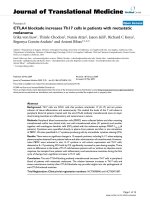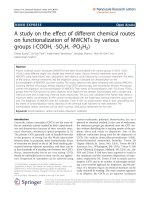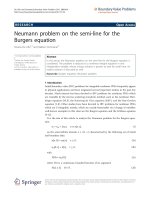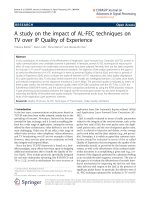Báo cáo hóa học: "A REMARK ON kTH-ORDER LINEAR FUNCTIONAL EQUATIONS WITH CONSTANT COEFFICIENTS" pdf
Bạn đang xem bản rút gọn của tài liệu. Xem và tải ngay bản đầy đủ của tài liệu tại đây (512.39 KB, 8 trang )
A REMARK ON kTH-ORDER LINEAR FUNCTIONAL
EQUATIONS WITH CONSTANT COEFFICIENTS
JITKA LAITOCHOV
´
A
Received 30 January 2006; Accepted 18 May 2006
Abel functional equations are associated to a linear homogeneous functional equation
with constant coefficients. The work uses the space S of continuous strictly monotonic
functions. Generalized terms are used, because of the space S, like composite function, it-
erates of a function, Abel functional equation, and linear homogeneous functional equa-
tion in S with constant coefficients. T he classical theory of linear homogeneous functional
and difference equations is obtained as a special case of the theory in space S.Equivalence
of points and orbits of a point are introduced to show the connection between the lin-
ear functional and the linear difference equations in S. Asymptotic behavior at infinity is
studied for a solution of the linear functional equation.
Copyright © 2006 Jitka Laitochov
´
a. This is an open access article distri buted under the
Creative Commons Attribution License, which permits unrestricted use, distribution,
and reproduction in any medium, provided the original work is properly cited.
1. Introduction
The linear functional equations are considered in the space of real-valued functions of
arealvariablex
∈ , = (−∞,∞). The set N denotes the set of positive integers. The
set
Z denotes integers, and the set R denotes real numbers. Symbol C
0
() is the set of
continuous functions on the interval .
Definitions of the terms which we generalize in the space S can be found in [1–5].
In particular, we generalize the notions of iterates and linear homogeneous functional
equations with constant coefficients.
1.1. Definition of the space S. A function f
∈ C
0
()belongstoS if and only if it maps
the interval one-to-one onto the interval (a,b), where a
∈ R or a =−∞, b ∈ R or
b
=∞.
1.2. Multiplication in S. Let us choose in S an arbitrary function X, a so-called canonical
function,andletX
∗
be the inverse function to X.LetF,G ∈ S. The composite function
H
= FX
∗
G(x)willbecalledaproduct and denoted by H = F ◦ G.
Hindawi Publishing Corporation
Advances in Difference Equations
Volume 2006, Article ID 72615, Pages 1–8
DOI 10.1155/ADE/2006/72615
2 A remark on linear functional equations
It is easy to show that H
∈ S. The set S with the operation of multiplication ◦ forms
a noncommutative group Ᏻ, where the canonical function X is the neutral element. Fur-
ther, to each element F
∈ S there is an inverse element F
−1
= XF
∗
X in Ᏻ,whereF
∗
∈ S is
the inverse function to F
∈ S.
Boldface promotion of symbols will be used to denote elements of Ᏻ.ThenF,G
∈ S
correspond to F,G
∈ Ᏻ and Ᏻ-multiplication is defined by composition:
F
◦ G(x) ≡ F
X
∗
G(x)
. (1.1)
If f
∈ C
0
(), Φ ∈ S, then the product f ◦ Φ(x) (not necessarily in Ᏻ)isdefinedtobe
the composite function f (X
∗
(Φ(x))) ∈ C
0
(). In general, f is not one-to-one; boldface
promotion of f is disallowed, because f
∈ S.
1.3. Iteration in S. Let X
∈ S be the canonical function. Let Φ ∈ S.Theiterates of the
function Φ in S are given by group operations as follows:
Φ
0
(x) = X(x),
Φ
n+1
(x) = Φ ◦ Φ
n
(x), x ∈ , n = 0, 1,2, ,
Φ
n−1
(x) = Φ
−1
◦ Φ
n
(x), x ∈ , n = 0, −1,−2, ,
(1.2)
where Φ
−1
is the inverse element to the element Φ in S according to multiplication ◦ in
group Ᏻ.
2. Linear functional equations of the kth order with constant coefficients
Let a
j
∈ R, j = 0,1,2, ,k. Then the equation
a
k
f ◦ Φ
k
(x)+a
k−1
f ◦ Φ
k−1
(x)+···+ a
1
f ◦ Φ
1
(x)+a
0
f ◦ Φ
0
(x) = 0 (2.1)
in S is called a linear homogeneous functional equation of kth order with constant coef-
ficients.Thecoefficients are the constants a
j
, j = 0,1,2, ,k. It is assumed that a
k
= 0.
A solution of (2.1) is a function f
∈ C
0
() that satisfies the equation for all x. It is not
assumed that f is one-to-one.
Let g(x)
= X(x +1)andletΦ ∈ S. The generalized Abel functional equation
α
◦ Φ(x) = g ◦ α(x) (2.2)
is called the associated functional equation to (2.1). A solution of (2.2)isafunctionα
∈ S
such that (2.2)holdsforallx.
The algebraic equation
a
k
λ
k
+ a
k−1
λ
k−1
+ ···+ a
1
λ + a
0
= 0 (2.3)
is called the characteristic equation of (2.1). The left side of (2.3)iscalledthecharacteristic
polynomial of (2.1).
Jitka Laitochov
´
a3
Theorem 2.1. Let (2.1)begiven.Letλ
1
,λ
2
, ,λ
k
be simple positive roots of the characteris-
tic equation (2.3). Let α be a continuous solution of the associated Abel functional equation
(2.2). The n the functions
f
1
= λ
X
∗
α(x)
1
, f
2
= λ
X
∗
α(x)
2
, , f
k
= λ
X
∗
α(x)
k
, (2.4)
are linearly independent solutions of (2.1).
Proof. Functions (2.4)havetheform
f
= λ
X
∗
α(x)
, (2.5)
where α
∈ S is a solution of the Abel equation (2.2)andX
∗
α(x) denotes the composite
function X
∗
(α(x)). Substitute (2.5)into(2.1), then
k
n=0
a
n
λ
X
∗
α◦Φ
n
(x)
= 0. (2.6)
Abel functional equation (2.2) implies
X
∗
α ◦ Φ
n
(x) = X
∗
X
X
∗
α(x)+n
=
X
∗
α(x)+n, (2.7)
n
= 0,1,2, ,k, and then
λ
X
∗
α(x)
k
n=0
a
n
λ
n
=
0. (2.8)
Thus the function (2.5)isasolutionof(2.1)ifλ is a root of the characteristic equation
(2.3). Roots of the characteristic equation have to be positive for the functions (2.5)tobe
defined.
To show the solutions (2.4) are linearly independent, consider a linear combination
c
1
f
1
(x)+··· + c
k
f
k
(x) = 0forallx. Choose samples x = X
∗
(x
0
), x = X
∗
(Φ(x
0
)), x =
X
∗
(Φ
2
(x
0
)), and so forth, and form the matrix equation Ac = 0 for the coefficients c,
using the sampling matrix
A
=
⎛
⎜
⎜
⎜
⎜
⎜
⎝
f
1
◦ Φ
0
x
0
f
2
◦ Φ
0
x
0
···
f
k
◦ Φ
0
x
0
f
1
◦ Φ
1
x
0
f
2
◦ Φ
1
x
0
···
f
k
◦ Φ
1
x
0
.
.
.
.
.
.
.
.
.
.
.
.
f
1
◦ Φ
k−1
x
0
f
2
◦ Φ
k−1
x
0
···
f
k
◦ Φ
k−1
x
0
⎞
⎟
⎟
⎟
⎟
⎟
⎠
. (2.9)
Abel equation can be used to show that det(A)
= 0foranyx
0
in . The idea is born
from the relation f
r
◦ Φ
n
(x) = f
r
(x) λ
n
r
and the theory of Vandermonde determinants.
Therefore, c
= 0 and the functions are independent. The proof is complete.
Automorphic functions. A function p ∈ C
0
()iscalledautomorphic ov er Φ provided
p
= p ◦ Φ. While constant functions are automorphic with respect to any Φ,thereare
examples of nonconstant automorphic functions. One such is p(x)
= sin(π(x − n)) on
4 A remark on linear functional equations
n
≤ x<n+ 1, which satisfies p(x) = p(x +1)or p = p ◦Φ for Φ(x) = x +1.Otherscanbe
constructed from this example.
Theorem 2.2. Let (2.1)begivenhavingsolution f
0
.Letp be a continuous automorphic
function, p
= p ◦ Φ. Then f (x) = p(x) f
0
(x) is also a solution of (2.1).
A more general solution is of the form
c
1
f
1
+ c
2
f
2
+ ···+ c
k
f
k
, (2.10)
where c
1
,c
2
, ,c
k
are automorphic functions over Φ and f
1
, , f
k
are solutions of (2.1).
Proof. The details to show f
0
satisfies (2.1)areasfollows:
k
n=0
a
n
pf
0
◦
Φ
n
(x) =
k
n=0
a
n
p ◦Φ
n
(x)
f
0
◦ Φ
n
(x)
=
k
n=0
a
n
p(x)
f
0
◦ Φ
n
(x)
=
p(x)
k
n=0
a
n
f
0
◦ Φ
n
(x)
=
0.
(2.11)
The proof is complete.
Theorem 2.3. Let (2.1)begiven.Letλ
0
be a positive real root of characteristic equation
(2.3), of multiplicity s, 1
≤ s ≤ k.Letα(x) be a continuous solution of Abel functional equa-
tion (2.2)andletX
∗
be the inverse function to canonical function X. Then the functions
f
r
=
X
∗
α(x)
r
λ
X
∗
α(x)
0
,0≤ r<s, (2.12)
are independent solutions of (2.1).
Proof. Let p(λ) denote the characteristic polynomial. Assume for the first part of the
proof that X is the identity map. Define f (x)
= (α(x))
r
λ
α(x)
0
. The following lemmas will
be applied to complete the proof.
Lemma 2.4. If L
= λ(d/dλ), then L
q
(p(λ)) =
k
n
=0
n
q
a
n
λ
n
for q ≥ 0.
Lemma 2.5. If λ
= λ
0
and 0 ≤ m ≤ r<s, then
k
n
=0
n
r−m
a
n
λ
n
= 0.
Jitka Laitochov
´
a5
Lemma 2.6.
{(α(x))
r
λ
α(x)
0
}
s−1
r
=0
are independent if and only if the powers {(α(x))
r
}
s−1
r
=0
are
independent.
Lemma 2.7. Let t
n
= α(x
0
)+n. Define mat rix
A
=
⎛
⎜
⎜
⎜
⎜
⎝
1 t
1
··· t
s−1
1
1 t
2
··· t
s−1
1
.
.
.
.
.
.
.
.
.
.
.
.
1 t
s
··· t
s−1
s
⎞
⎟
⎟
⎟
⎟
⎠
. (2.13)
Then det(A)
= 0 and the powers of Lemma 2.6 are independent.
The proofs of the lemmas: for Lemma 2.4 use induction on q.ForLemma 2.5 the left
side of the equation is L
q
(p(λ)) for q = r − m ≥ 0. Apply Lemma 2.4. Expand L
q
(p(λ)) by
calculus to verify that being zero at λ
= λ
0
is possible because the derivatives (d/dλ)
n
p(λ)
are zero at λ
= λ
0
for 0 ≤ r<s, due to multiplicity of the root λ
0
.ForLemma 2.6 write
down a linear combination equal to zero. Cancel λ
α(x)
0
.ForLemma 2.7 the determinant is
a Vandermonde determinant, known to b e nonzero for distinct sample values t
1
, ,t
s
.
The connection to the Abel equation is made by choosing sample values x
= x
0
, x =
Φ(x
0
), and so forth, in the linear combination c
1
+ c
2
α(x)+··· + c
s
(α(x))
s−1
= 0, and
then writing t he system Ac
= 0 for vector c to show c = 0.
The proof that functions (2.12) satisfy the equation proceeds by inserting f into (2.1).
The binomial formula (a + b)
r
=
r
m
=0
r
m
a
m
b
r−m
is applied to give
k
n=0
a
n
f ◦ Φ
n
(x) =
k
n=0
a
n
α(x)+n
r
λ
α(x)+n
0
=
r
m=0
r
m
k
n=0
n
r−m
a
n
λ
n
0
α(x)
m
λ
α(x)
0
=
r
m=0
r
m
(0)
α(x)
m
λ
α(x)
0
= 0,
(2.14)
the last step is justified by Lemma 2.5.
Independence follows directly from Lemmas 2.6 and 2.7. The details of proof for gen-
eral X paral lel the above steps, essentially replacing α by X
∗
α.Theproofiscomplete.
Theorem 2.8. If the characteristic equation (2.3) has conjugate complex roots λ
1
=
¯
λ
2
=
r(cosω + isin ω), then the corresponding linear homogeneous functional equation possesses
two solutions in the form
f
1
= r
X
∗
α(x)
cos
ωX
∗
α(x)
, f
2
= r
X
∗
α(x)
sin
ωX
∗
α(x)
. (2.15)
Theproofislefttothereader.
6 A remark on linear functional equations
3. An application
Let S be the space of all continuous functions which map the interval (
−∞,∞) one-to-
one onto itself. Let the canonical function be X(x)
= x (identity), then X
∗
(x) = x.Let
Φ(x)
= x + 1. The Abel functional equation is then
α(x +1)
= α(x)+1. (3.1)
A linear homogeneous functional equation with constant coefficients is
a
k
f Φ
k
(x)+a
k−1
f Φ
k−1
(x)+···+ a
1
f Φ
1
(x)+a
0
, f Φ
0
(x) = 0, (3.2)
where f Φ
j
(x) is a composite function f (Φ
j
(x)), j = 1,2, ,k,andΦ
j
is defined by suc-
cessive composition. Suppose λ>0 is a root of the characteristic equation. By the theo-
rems above, it has a solution of the form
f
= λ
α(x)
, (3.3)
where α satisfies Abel equation (3.1).
Linear system (3.2)isalineardifference equation with constant coefficients of the
form
a
k
f (x + k)+a
k−1
f (x + k − 1) + ···+ a
1
f (x +1)+a
0
f (x) = 0, (3.4)
because Φ(x)
= x + 1. Abel equation (3.1)hasasolutionα(x) = x.Ifλ is a positive root of
the characteristic equation, then the function f
= λ
x
is a solution of (3.4).
3.1. Equivalence of points in , orbit of a point in S. Let Φ
∈ S. Two points x, y ∈ are
Φ-equivalent if and only if there are numbers μ,ν
∈ Z such that
Φ
μ
(x) = Φ
ν
(y). (3.5)
The equivalence is reflexive, symmetric, and transitive. It means that there is a decompo-
sition of the set into disjoint sets of equivalent points.
The set O
Φ
(x
0
) of all points Φ-equivalent to a point x
0
∈ J is called the Φ-orbit of the
point x
0
.
For the classical difference equation (3.4), in which X(x)
= X
∗
(x) = x and Φ(x) =
x +1, the orbit of 0 is the set Z of integers and the orbit of x
0
is the translate of this set by
x
0
: O
Φ
(x
0
) ={x
0
+ μ}
∞
μ=−∞
.
Lemma 3.1. Let x
0
∈ , μ,ν ∈ Z.Let
x
μ
= X
∗
Φ
μ
x
0
. (3.6)
Then the set of points
{x
μ
}
∞
μ=−∞
is the Φ-orbit of the point x
0
.
Jitka Laitochov
´
a7
Proof. Because Φ
0
= X and x
μ
∈ ,thenx
0
= X
∗
Φ
0
(x
0
). Let p,q ∈ Z. To show that each
two points x
p
, x
q
defined by (3.6)areΦ-equivalent in , we will show that there are
numbers μ,ν
∈ Z such that
Φ
μ
x
p
=
Φ
ν
x
q
. (3.7)
Use formula (3.6) to show that (3.7)isequivalentto
Φ
μ
X
∗
Φ
p
x
0
=
Φ
ν
X
∗
Φ
q
x
0
. (3.8)
The definition of multiplication
◦ implies the above is equivalent to
Φ
μ+p
x
0
=
Φ
ν+q
x
0
. (3.9)
Choose μ
= q, ν = p to obtain (3.7).
3.2. Behavior of solutions at infinity. Consider a linear homogeneous kth-order func-
tional equation with constant coefficients (2.1). Let the characteristic equation (2.3)have
roots satisfying
λ
1
>λ
2
> ···>λ
k
> 0. (3.10)
Let α
∈ S be a solution of the Abel functional equation (2.2)andletX
∗
be the inverse
function to canonical function X.Assumec
1
, ,c
k
are continuous Φ-automorphic func-
tions on J, that is, c
j
= c
j
◦ Φ. Then a solution of (2.1)isgivenby
f (x)
= c
1
(x) λ
X
∗
α(x)
1
+ c
2
(x) λ
X
∗
α(x)
2
+ ···+ c
k
(x) λ
X
∗
α(x)
k
. (3.11)
The right side of (3.11) can be rearranged into the expression
f (x)
= λ
X
∗
α(x)
1
c
1
(x)+c
2
(x)
λ
2
λ
1
X
∗
α(x)
+ ···+ c
k
(x)
λ
k
λ
1
X
∗
α(x)
. (3.12)
The inequalities
0 <
λ
j
λ
1
< 1, j = 2,3, ,k, (3.13)
imply
lim
x→∞
c
j
(x)
λ
j
λ
1
X
∗
α(x)
= 0. (3.14)
Formally, at least,
lim
x→∞
f (x) = lim
x→∞
c
1
(x) λ
X
∗
α(x)
1
. (3.15)
8 A remark on linear functional equations
We will discuss the meaning of (3.15). The following situations can occur.
(1) If λ
1
> 1, then lim
x→∞
f (x) =∞, because lim
x→∞
X
∗
α(x) =∞.
(2) If λ
1
= 1, then lim
x→∞
f (x) does not generally exist.
(3) If λ
1
< 1, then lim
x→∞
f (x) = 0, because lim
x→∞
X
∗
α(x) =∞.
Consider (2.1)ontheΦ-orbit of a point x
0
∈ . Then sequences
λ
X
∗
αX
∗
Φ
n
(x
0
)
1
,
λ
X
∗
αX
∗
Φ
n
(x
0
)
2
, ,
λ
X
∗
αX
∗
Φ
n
(x
0
)
k
(3.16)
are the solutions evaluated along the Φ-orbit. Because α
∈ S satisfies Abel functional
equation (2.2), then the sequences can be written in the form
λ
α(x
0
)+n
1
∞
n=1
,
λ
α(x
0
)+n
2
∞
n=1
, ,
λ
α(x
0
)+n
k
∞
n=1
. (3.17)
Therefore, we have a solution formula
f
x
0
+ n
=
c
1
x
0
λ
α(x
0
)+n
1
+ c
2
x
0
λ
α(x
0
)+n
2
+ ···+ c
k
x
0
λ
α(x
0
)+n
k
. (3.18)
Using the ideas above, the limits at infinity are determined as follows.
(1) If λ
1
> 1, then {λ
α(x
0
)+n
1
} diverges to ∞ and lim
n→∞
f (x
0
+ n) =∞.
(2) If λ
1
= 1, then {λ
α(x
0
)+n
1
} is a constant sequence of ones and the sequence {c
1
(x
0
)
λ
α(x
0
)+n
1
} is a constant sequence of numbers c
1
(x
0
). Hence lim
n→∞
f (x
0
+ n) =
c
1
(x
0
).
(3) If 0 <λ
1
< 1, then the sequence {c
1
(x
0
)λ
α(x
0
)+n
1
} is a decreasing sequence conver-
gent to zero and lim
n→∞
f (x
0
+ n) = 0.
Note 3.2. The limit for x
→−∞can be determined using the same techniques of analysis.
Note 3.3. The results for behavior of solutions for difference equations can be obtained
from the results for (2.1). The idea is to e valuate along the orbit O
Φ
(x
0
), x
0
∈ .
References
[1] S.N.Elaydi,An Introduction to Difference Equat ions, 2nd ed., Undergraduate Texts in Mathe-
matics, Springer, New York, 1999.
[2] A.O.Gel’fond,Differenzenrechnung, Hochschulb
¨
ucher f
¨
ur Mathematik, vol. 41, VEB Deutscher
Verlag der Wissenschaften, Berlin, 1958.
[3] M. Kuczma, Functional Equations in a Single Variable, Monografie Matematyczne, vol. 46,
Pa
´
nstwowe Wydawnictwo Naukowe, Warsaw, 1968.
[4] M. Kuczma, B. Choczewski, and R. Ger, Iterative Functional Equations, Encyclopedia of Mathe-
matics and Its Applications, vol. 32, Cambridge University Press, Cambridge, 1990.
[5] F. Neuman, Funkcion
´
aln
´
ıRovnice, SNTL, Prague, 1986.
Jitka Laitochov
´
a: Mathematical Department, Faculty of Education, Palack
´
y University,
ˇ
Zi
ˇ
zkovo n
´
am
ˇ
esti 5, Olomouc 77140, Czech Republic
E-mail address:









